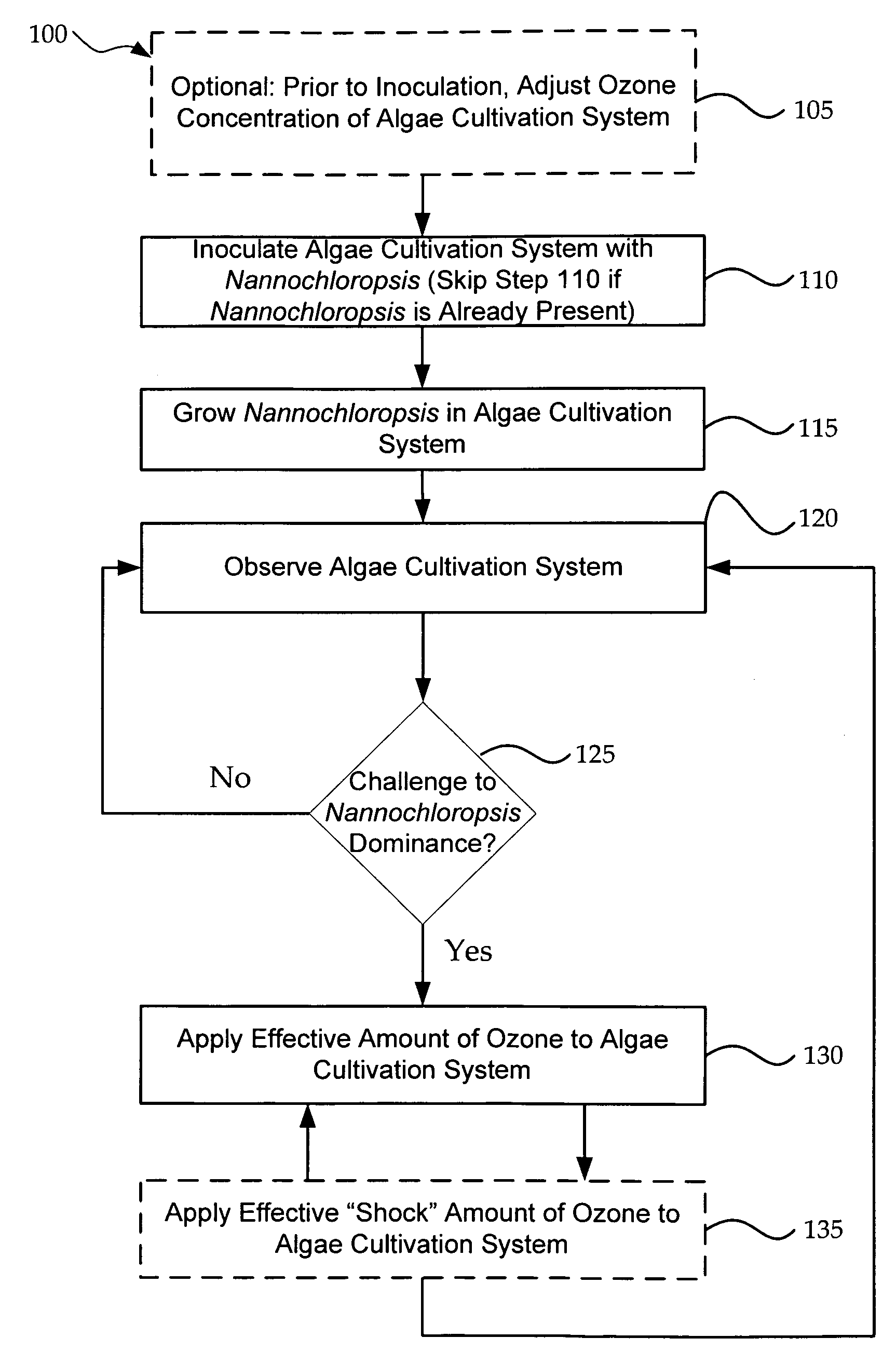Systems and methods for maintaining the dominance and increasing the biomass production of nannochloropsis in an algae cultivation system
a technology of algae cultivation and biomass production, applied in the field of algae cultivation systems, can solve the problems of nannochloropsis /i>, culture is subject to contamination by competing species and predators, etc., and achieve the effects of increasing the biomass production of nannochloropsis
- Summary
- Abstract
- Description
- Claims
- Application Information
AI Technical Summary
Benefits of technology
Problems solved by technology
Method used
Image
Examples
examples
[0024]In the following examples, Nannochloropsis was grown in outdoor, open, three-square meter ponds in Vero Beach, Fla. The climate in Vero Beach is semitropical, with mild, cool winters and hot, humid summers. It is a challenging climate for keeping outdoor algal cultures stable and productive. The overnight warmth encourages predation by protozoa, rotifers, and crustaceans. The humidity allows the airborne transport of competing algae, and thus increases the rate of invasion.
example one
[0025]Ozone was added to an algal cultivation system using a commercial ozone generator with accompanying liquid pump, venturi, and air dryer. The machine used was a small model capable of generating 10 grams of ozone per hour. The flow rate of liquid through the generator was about 16 liters per minute. At fifty percent (50%) of maximal ozone generation, the concentration of ozone in the liquid after one pass through the ozone generator was 4.6 mg / L, and at 100% was 9.6 mg / L.
[0026]Two three-square meter ponds were started by taking 500 L of culture from a larger pond and passing it through the ozone generator once. One pond was started with the ozonator setting at 50%, the other pond was started with the ozonator setting at 100%. The original algal culture had numerous clumps of Nannochloropsis, cell debris, various diatoms, and some ciliated protozoa grazers. After the one pass-through the ozone generator, only single cells of Nannochloropsis survived. The clumps were completely b...
example two
[0028]An ozone skid was assembled on-site utilizing a dry air feed ozone generator capable of producing 10 g / h of ozone. The intention of the tests was to demonstrate the effectiveness of ozone disinfection and Nannochloropsis resistance to concentrations of ozone.
[0029]A small pump was connected to the system with the ozone added to the liquid recycle line via a Mazzei gas to liquid injector capable of flow rates between 13.2-28.35 lpm@pressures ranging from 15-25 psi. Tests were run on ponds D4 (3 m2 surface area), MP1 (3 m2 surface area), and 25A (25 m2 surface area) with salinities ranging from 20-24 ppt using flow rates of 13.2 and 15.6 lpm@20 psi. The ozonator is equipped with a variable transformer that offers the ability to vary ozone dosage between 0-100%. Tests were run at ozone concentrations of 25%, 50%, 75%, and 100% at flow rates of 13.2 and 15.6 lpm. Respective ozone dosages at these flow rates are listed in the tables below.
[0030]
Ozone dosages @ 13.2 lpmOzone Concent...
PUM
| Property | Measurement | Unit |
|---|---|---|
| concentration | aaaaa | aaaaa |
| concentration | aaaaa | aaaaa |
| concentration | aaaaa | aaaaa |
Abstract
Description
Claims
Application Information
 Login to View More
Login to View More - R&D
- Intellectual Property
- Life Sciences
- Materials
- Tech Scout
- Unparalleled Data Quality
- Higher Quality Content
- 60% Fewer Hallucinations
Browse by: Latest US Patents, China's latest patents, Technical Efficacy Thesaurus, Application Domain, Technology Topic, Popular Technical Reports.
© 2025 PatSnap. All rights reserved.Legal|Privacy policy|Modern Slavery Act Transparency Statement|Sitemap|About US| Contact US: help@patsnap.com

